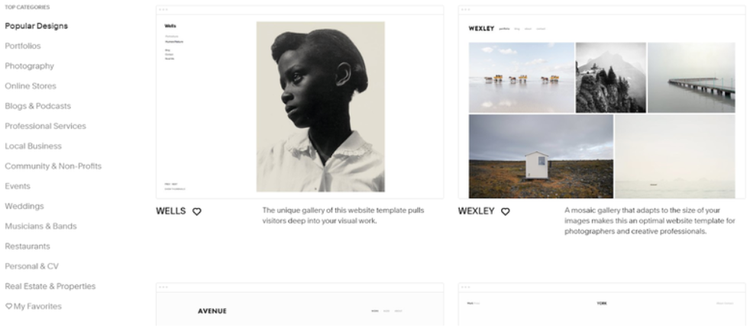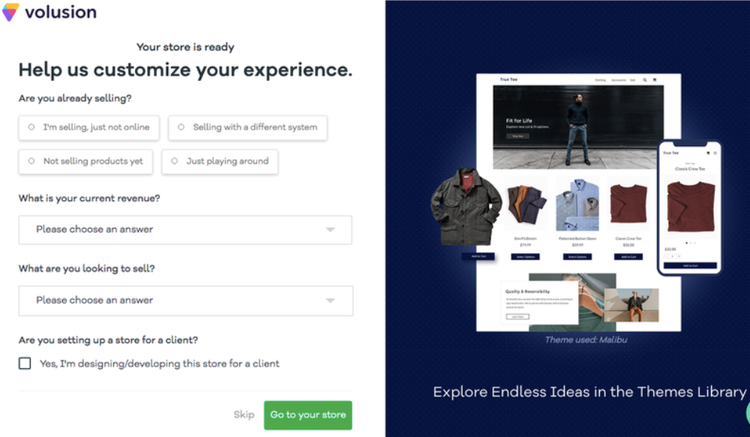
Image source: Getty Images
In this guide, we will look into the steps to create a videographer website. With the steps and tools shared in this post, you can create and run your videographer website in no time.
According to data gathered by Wyzowl, 85% of the businesses they surveyed used video as a marketing tool. This figure is a dead giveaway on why now, more than ever, is a great time to be a videographer.
Not only is there a strong demand for video creation services, but it’s also easy to create professional looking videographer websites with the abundance of videographer web templates available online.
These templates have landing page examples optimized for conversions. They’re packed with marketing functionality and their website management features are often easy to navigate, making it easy for videographers to run their online business.
As you learn how to build a website and employ the right website marketing strategies, you can refine your brand positioning as a videographer and establish yourself as an authority in your industry.
With this, whether you’re running a wedding videography website or a video marketing agency, it becomes easier for you to close deals and grow your business.
How to create a videographer website
Contrary to what others will have you think, creating a videographer website isn’t rocket science. If you are just starting your videography business, or you’ve been a videographer for quite some time but you’re only building your website now, the steps below will show you the way.
Step 1: Choose a domain name
If you’re new at building websites for videographers and you aren’t sure what a domain name is, it is basically your website name. In The Motley Fool’s case, the domain name is “Fool.com.”
When choosing a domain name, pick one that’s consistent with your brand name. In that way, your brand becomes even more recognizable and familiar to your audience.
Tips for choosing a domain name:
- Use the .com top-level domain (TLD): Most internet users assume that a website’s TLD is .com. If you use .me, .io, or other TLDs, your online searchers will have a hard time finding your site since you’re using a less familiar TLD.
- Short and simple: If you use a longer set of words and hard-to-spell domain names, you make it harder for your potential customers to find your website.
Step 2: Choose a reliable web hosting service provider
Just as buildings need to be built on solid and stable ground, your website should also be hosted by a reliable and stable service provider. The best videographer websites choose stable servers that load fast and will give you the least downtime.
Choose a poor-performing hosting provider, and your website will often be unreachable. It’ll also load slowly and won’t be able to handle huge amounts of website traffic.
Tips for choosing a web hosting service provider:
- Cheap is not always better: Don’t choose the cheapest web host you can get your hands on. Since you’ll be publishing a lot of videos on your website, you need to choose a provider with a good uptime score and one that’s reliable. You want your website to be operational and active all the time.
- Look out for security features: Check if the hosting provider has malware detection or firewalls on their servers, among other security features. Cyberattacks are on the rise, and the last thing you want is to compromise your customers’ sensitive information or have a hacker take over your website.
Step 3: Choose a content management system
Because your online presence as a videographer is so important, you need to “house” your business on the best content management system (CMS). And by best, I’m referring to a platform that can meet your particular business needs.
It should give you the flexibility to design your website the way you want it to look and perform. It also needs to have ample features such as marketing analytics, social media integration, video platform integrations, etc.
The more features the CMS has, the better. They will always come in handy down the line as you expand.
Tips for choosing a CMS:
- Choose a platform that supports omnichannel: As your videography business grows, you’ll uncover channels that are worth pursuing when reaching out to your customers. Using a CMS with omnichannel features will make it easier for you to manage your marketing efforts and your community because of the advanced level of connectivity it provides.
- Usability and function: When choosing a CMS, it pays to think about who will manage your website. Do you have a team of knowledgeable marketers or web developers who can manage your CMS? Or will it be operated by people who are new to website management?
There’s no point in choosing a platform that 99% of your team doesn’t understand and can’t use.
Step 4: Choose a website template
You can choose from many website templates. In fact, if you Google the keyword phrase “best portfolio websites,” you’ll be flooded with pages where you can either build your videographer websites or view samples of professional looking ones.
As you examine the search results, you can use these resources as benchmarks on how to create a stunning videographer website. Some of the results are also website builder platforms that you can use to build your site.
Tips for choosing a website template:
- Simple but compelling: The more elements you have on your website, the more distracting it becomes. Instead of choosing a template with umpteen pop-ups, sliders, banners, etc., choose a website template that looks clean, crisp, and professional.
Doing so, you can be assured your web visitors are going to focus on your video and text-based content rather than be distracted by other distracting web elements.
- Go for SEO-friendly templates: Not all templates are created equal. Some just look good while there are those that look good and are search engine friendly.
This is important because many of your prospects will come from search engines such as Google and Bing. If your website isn’t SEO friendly, it’ll be hard for your page to rank on top of search engine results pages (SERPs).
Step 5: Customize your website design
A common mistake some videographers make when creating their website is to focus on aesthetics and features only. While both are certainly important, they shouldn’t be the overarching theme when customizing web design and layout.
The primary focus should be conversions — turning web visitors into paying customers. After all, to keep your videography business afloat and thriving, you need clients.
With that in mind, don’t just focus on aesthetics when customizing your design. Put a premium on whether or not your layout would compel your audience to reach out to you and ask about your services. Be sure to include convincing and trust-building elements like testimonials, case studies, and portfolio pieces.
Tips for customizing your web design:
- Optimize your webpages for conversion: Having a professional looking webpage isn’t enough. You need to optimize your web page for conversions so your web visitors will contact you for your services instead of them just appreciating the beauty of your website.
- Don’t bombard your web visitors with needless calls-to-action (CTA): The more CTAs you add on a single web page, the more confusing it becomes for your web visitors. This can easily prompt them to click away without asking about your business.
A good rule of thumb to follow is to limit each page to one CTA. Don’t ask your web visitors to share, comment, and sign up at the same time. Pick one CTA and optimize your page for that alone.
Step 6: Upload your content
At this point, your videographer website’s layout is ready. All you need to do is upload all of your content to replace the placeholders on your videographer website.
When you start your uploading process, you might come across some alignment or layout issues, so be mindful of them. Also, be very meticulous about the content you upload.
You need to ask yourself if this piece of content will help you achieve your objectives, or will it only distract your visitors? If it’s the latter, then don’t bother adding the content.
Tips for uploading your content:
- Be mindful of your content’s file type and size: Your content file type and size can impact your website’s load speed. The bigger the content, the slower your website loads. Sometimes the difference in load speed might not be noticeable, but if you upload on a regular basis, you are bound to see its damaging effects.
Not only will your website load slowly, but, as a result, you’ll see your website’s bounce rate skyrocket due to visitors clicking away.
- Talk about your audience’s pain points: Whether uploading a video or text-based content, it pays to talk about your audience’s problems or pain points. Make your content about them, not just you.
Doing so makes your content more relatable. This also allows you to build a meaningful relationship with your visitors as you share solutions to their problems. This can ultimately translate to them reaching out to you for your services.
The best website building tools for videographers
Building your website can take some time and effort, but with the right platform, videographer website templates, tools, and apps, you can make the process a lot less complicated and overwhelming.
To give you a better idea of what’s up for grabs in the market, allow me to share with you three platforms that you can use to create your videography website.
While some of these aren’t necessarily built for videographers, they have the bells and whistles videographers need to create a professional looking site.
1. Squarespace
Squarespace is a versatile platform that is perfect for building artist sites or just about any type of website. Although the website builder focuses on the online selling industry, Squarespace’s features can serve a wide variety of users with its tools and design options.
The platform’s themes are easy to work with and designed to be aesthetically stunning, which is best for showcasing videography portfolio websites.
With Squarespace’s smart template feature, you can easily change templates without worrying about losing your content.

Look at these sample website templates from Squarespace. Image source: Author
The platform also offers blogging functionality that you can use to post blogs, schedule posts, set up commenting features, and more.
Building your content on Squarespace is structured in a way that you’re mostly completing sections, so even if it’s your first time to create a website, you can easily understand and follow along.
This platform also boasts of its clutter-free interface assuring you of a beautiful and clean videographer website.
2. BigCommerce
Although BigCommerce is often used by e-commerce entrepreneurs, the platform can also be used by videographers because of its myriad of features.
The platform is perfect for videographer business websites because it can be used to sell merch and other videography gear.
Because BigCommerce has several e-commerce-related features, you’ll be able to run your transactions through your website seamlessly.
The platform also offers a library of themes and templates that you can customize according to your needs. You can easily display your videographer portfolio examples and present your services and products.

You can customize themes according to your preference in BigCommerce. Image source: Author
Other useful BigCommerce features include automatic website optimization to show you how your videographer site looks on various displays, payment gateway integrations, etc.
Plus, the platform provides in-depth analytics, providing insights into essential data, such as customer behavior, which is useful information for improving your website or when making business decisions.
2. Volusion
When it comes to website themes, Volusion offers a wide variety of designs. Setting up your website with Volusion is straightforward and intuitive since the platform provides a customized setup that guides you through the process.

Volusion’s customized setup process makes building your website easy. Image source: Author
With this, you won’t need to get into any hard coding, letting you focus on creating stunning videos for your clients.
Building your videographer website is easy
Creating a videographer website has never been easier. With the abundance of easy-to-use tools and platforms, you can now create your websites in just a matter of hours.
If you’re looking to build your own videography website, start by following the steps outlined in this post so you have a firm framework to follow.
Expert-picked business credit cards with rich rewards and perks
Cash back, travel rewards, 0% intro APR financing: all of these can be great credit card perks for business owners. But how do you find the right business credit card for you? There are tons of offers on the market today, and sifting through them to find the right one can be a big hassle. So we’ve done the hard work for you.
Get started with one of our top business credit card picks of 2022 today.





